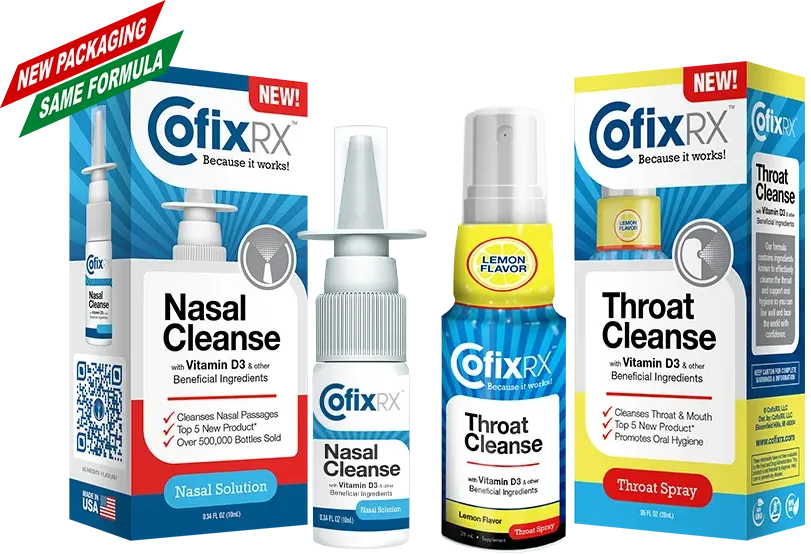We recently entered the 3rd year of the Coronavirus Pandemic. As we enter a new phase of the pandemic it is important that we have tools in place to protect our communities.Communities have moved away from wearing masks and many people have been in search of other ways to protect themselves. At CofixRX we have an amazing product that can be used daily to block and destroy viruses. As stated by JAMA, Covid-19 will never be fully eradicated. Studies have shown treating the nasopharynx with a povidone iodine nasal spray greatly reduces the transmission of germs and pathogens.With the increased availability of antivirals available,including CofixRX we can effectively equip our communities.
Now in the third year of the coronavirus pandemic, well after the Omicron variant surge, both in the US and globally the number of daily cases had been declining to their lowest levels in more than 6 months. While it seemed that SARS-CoV-2 was moving toward endemicity, US infections are again rising in May 2022, and the reported number of cases is likely a gross underestimate of actual infections because many infections are unreported with increasing at-home testing. Several factors help explain the current trends: The emergence of the BA.2 subvariant of Omicron and the more recently identified subvariant called BA.2.12.1, the limited durability of protection from infection both from vaccination and prior infection, and lifting of mandates (such as mask use) and other restrictions across the country.
Subvariants of Omicron
After the Omicron variant (BA.1) was first identified in South Africa in November 2021, it quickly spread worldwide, outcompeting other variants and rapidly becoming the predominant variant in many countries including the US. Since then, several lineages and sublineages have emerged. The most common now are BA.1, BA.1.1, BA.2, and BA.2.12.1.
The BA.2 variant effective reproduction number is 1.4-fold higher than that of BA.1. Its viral fitness is due to 53 mutations, 29 of which are in the spike protein. The clinical manifestations of BA.2 infection are similar to those of BA.1, with mild upper respiratory symptoms (such as sore throat and pharyngitis) being common. In addition, many patients report gastrointestinal symptoms (eg, diarrhea, nausea, and vomiting) along with nonspecific symptoms (eg, muscle aches, headache, nasal congestion, and fatigue).
First identified in New York, BA.2.12.1 is now the dominant variant in the US. As of May 25, 2022, about 58% of SARS-CoV-2 isolates sequenced were BA.2.12.1. This subvariant has additional spike mutations S704L and L452Q on top of BA.2 background. The L452Q mutation had been previously observed in the Delta and Lambda variants and allows the virus to attach more tightly to the angiotensin-converting enzyme 2 receptor and thus become more transmissible. Prior infection with BA.1 appears to offer minimal cross-immunity to BA.2.12.1, thus people who had Omicron infection with BA.1 can also get infected with BA.2.12.1.
Two other variants, BA.4 and BA.5, have recently emerged in South Africa and in Europe and have been identified as Variants of Concern Lineages Under Monitoring by the World Health Organization. Like other Omicron subvariants, BA.4 and BA.5 appear to be significantly more transmissible than previously identified (pre-Omicron) variants. While experiments suggest that at least some of the competitive advantage of BA.4 and BA.5 could be due to differences in viral replication, other factors such as immune evasion or intrinsic transmissibility could also contribute to the observed differences in epidemic growth rates.
As with BA.2.12.1, individuals previously infected with an earlier Omicron variant (BA.1) do not appear to be well protected against infection from BA.4 and BA.5. Fortunately, BA.4 and BA.5 do not seem to cause more severe disease than previous variants. In the US, BA.2 and BA.2.12.1 remain the dominant variants as of mid-May 2022, but it is likely that more cases will result from BA.4 and BA.5 infection as the summer approaches and as more cases are imported from South Africa and Europe. In summary, since the emergence of Omicron, SARS-CoV-2 is rapidly becoming much more efficient in transmission and more likely to evade immunity.
Controlling Spread of COVID-19

As the initial Omicron wave was receding in the US, the Centers for Disease Control and Prevention (CDC) launched on March 3, 2022, the COVID-19 Community Level indicator, a new tool to help communities decide what prevention steps to take. Levels can be low, medium, or high as determined by hospital bed utilization, hospital admissions, and total number of COVID-19 cases in a community. When the tool was first launched, more than 90% of the US population lived in locations with a low or medium COVID-19 Community Level where indoor masking was not considered essential. As of May 25, 2022, when daily reported COVID-19 cases are increasing and approaching 100 000, about 9.2% of counties are in the high Community Level. This contrasts with the CDC Community Transmission indicator in which more than two-thirds of counties in the US are in the high transmission level. The existence of 2 different CDC metrics that provide almost opposing information adds to confusion and makes recommendations on the use of nonpharmacologic interventions, such as masking, more difficult. In addition, focusing on the COVID-19 Community Levels metric contributes to the myth that the pandemic is over, something everyone wants to believe is true but certainly is not.
Given the fact that many places are no longer requiring masking, people who wish to mask are left wondering what to do and if 1-way masking (wearing a mask while the surrounding individuals are not masked) provides any protection. The data suggest that 1-way masking is still effective but that for maximum protection the person should wear a high-quality and well-fitting mask such as an N95 or a KN95. However, an estimated 60% of KN95 masks available in the US were found to be substandard or counterfeit during evaluations conducted in 2020. KN95s do not meet National Institute for Occupational Safety and Health (NIOSH) standards. NIOSH-approved respirators have an approval label on or within the package of the respirator and, for the most part, have headbands instead of ear loops.
COVID-19 Vaccine Boosters

Mutations present in Omicron and its subvariants have been associated not only with increased transmissibility, but also with immune evasion to both vaccination and immunity after infection. Primary immunization with 2 doses of mRNA vaccines provides limited protection against symptomatic disease caused by Omicron that increases substantially after a booster. mRNA vaccines offer a similar degree of protection against BA.1 and BA.2 although protection against infection and symptomatic disease wanes within months of a third dose. In contrast, vaccine-associated protection against severe illness, including hospitalization and death, remains durable.
Given the decline in protection against symptomatic infection, a fourth dose of mRNA vaccine in high-risk individuals (older adults and those who are highly immunocompromised) has been proposed as a preventive strategy. Data from Israel suggest that a fourth dose is associated with lower risk of symptomatic infection, hospitalization, severe disease, and death among older adults, but has only marginal benefits in most individuals for whom protection against severe disease remains after a primary series and third dose. Currently, a fourth vaccine dose is recommended by the CDC only for individuals older than 50 years who received their booster at least 4 months ago and those 12 years and older who are moderately or severely immunocompromised and who have gotten their booster at least 4 months prior. As is the case with other vaccines, the goal of vaccination against COVID-19 is to protect against serious illness, not prevent all infections. However, it is increasingly clear that with Omicron and its many subvariants, protection from severe disease requires 3 doses of an mRNA vaccine, something the CDC has termed “up-to-date.” However, less than 50% of those older than 12 years and only 69% of those 65 years and older have received a third vaccine dose.
Emerging data suggest that prior COVID-19 infection provided robust protection against the Alpha, Beta, and Delta variants but limited protection against Omicron. However, the combination of a previous SARS-CoV-2 infection and vaccination (“hybrid immunity”), seems to confer the greatest protection against symptomatic infection although clinically, repeat infections are being seen frequently.
Therapeutics

With the increased availability of effective antiviral agents and monoclonal antibodies for the treatment of COVID-19, the Biden administration launched a new initiative called Test to Treat in March 2022. Yet, the program has been underutilized because of logistical barriers, such as the need to initiate treatment within 5 days of symptom onset, and practical concerns, such as serious drug-drug interactions, need for dosing according to kidney function, and potential teratogenicity. Making COVID-19 testing readily available along with rapid linkage to treatment resources will require substantial efforts and a sustainable infrastructure. Planning must ensure that these resources are easily available to those individuals who are not connected to the health care system.
In addition, as nirmatrelvir/ritonavir is increasingly being prescribed, reports of relapse, both with recurrence of symptoms and a positive antigen test result, shortly after ending a 5-day course of treatment are being described. As of now, it is unclear why or how often this is occurring, but these observations warrant monitoring at a population level. In addition, it is unclear whether a longer course of treatment (eg, 10 days rather than 5) or an additional course of treatment is indicated after relapse. Of note, the clinical trials that evaluated both nirmatrelvir/ritonavir and molnupiravir were conducted among unvaccinated individuals at high risk for severe illness. In contrast, most people who are currently being prescribed oral antivirals have been vaccinated. Thus, there are currently no data on the efficacy or response to treatment among vaccinated individuals; however, until the data become available, it is reasonable to prescribe these medications to people who are infected and at high risk of severe COVID-19.
Conclusions

While many questions remain about the future of the pandemic, it is clear that SARS-CoV-2 will not be fully eradicated. This means continuing to adapt to life with COVID-19 and recognizing that during the next phase of the pandemic, there will be times when community transmission will be low and precautions can be “dialed down” and times when increased transmission will require mitigation efforts to be “dialed up.”
If COVID-19 moves toward endemicity, then it should not disrupt everyday life. However, with ongoing transmission and with an estimated 10% to 30% of individuals experiencing long COVID symptoms after infection, this issue will require careful attention to further define the syndrome and possible intervention (such as the RECOVER cohort study at the National Institutes of Health). Data suggest that vaccination can decrease the risk of long COVID and thus continuing to focus on improving vaccination rates must remain the cornerstone of COVID-19 prevention and mitigation not only locally, but globally.
Original source, references, and comments at JAMA Network Site.

